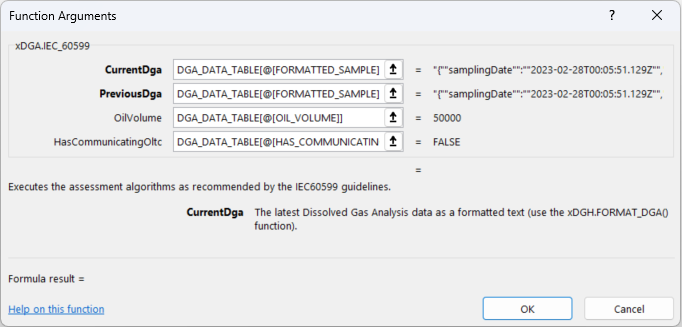IEC_60599

Formula
=IEC_60599(currentDga, previousDga, oilVolume?, hasCommunicatingOltc?)
Description
Executes the assessment algorithms as recommended by the IEC60599 guidelines.
If the 'hasCommunicatingOltc' parameter is not entered the value defaults to false.
Output
The outcome of the application of this rule.
Algorithm|Interpretation of Dissolved Gas Analysis as per IEC 60599 Edition 4.0 2022-05
-5.4 Basic gas ratios|Analysis for sample taken on Tue Feb 28 2023
--5.4 Table 1 - DGA interpretation table outcome|T1 => Thermal fault t < 300 oC
--Potential failure modes as per A.2.2 Typical faults, Table A.1 - Typical faults in power transformers|Overloading of the transformer in emergency situations
Blocked item restricting oil flow in windings
Stray flux in clamping beams of yokes
-5.4 Basic gas ratios|Analysis for sample taken on Sun Jan 31 2021
--5.4 Table 1 - DGA interpretation table outcome|T1 => Thermal fault t < 300 oC
--Potential failure modes as per A.2.2 Typical faults, Table A.1 - Typical faults in power transformers|Overloading of the transformer in emergency situations
Blocked item restricting oil flow in windings
Stray flux in clamping beams of yokes
-5.6 O2/N2 ratio|Analysis for sample taken on Tue Feb 28 2023
--Oxygen to Nitrogen ratio|Dissolved O2 and N2 are found in oil as a result of contact with atmospheric air in the conservator of air-breathing equipment, or through leaks in sealed equipment. At equilibrium with air, the concentrations of O2 and N2 in oil are approximately 32 000 ppm and approximately 64 000 ppm, respectively, and the O2/N2 ratio is approximately 0,5.
In service, this ratio may decrease as a result of oil oxidation and/or paper ageing, if O2 is consumed more rapidly than it is replaced by diffusion. Factors such as the load and preservation system used may also affect the ratio, but with the exception of closed systems, ratios less than 0.3 (0.25 in this case) are generally considered to indicate excessive consumption of oxygen.
-5.6 O2/N2 ratio|Analysis for sample taken on Sun Jan 31 2021
--Oxygen to Nitrogen ratio|Dissolved O2 and N2 are found in oil as a result of contact with atmospheric air in the conservator of air-breathing equipment, or through leaks in sealed equipment. At equilibrium with air, the concentrations of O2 and N2 in oil are approximately 32 000 ppm and approximately 64 000 ppm, respectively, and the O2/N2 ratio is approximately 0,5.
In service, this ratio may decrease as a result of oil oxidation and/or paper ageing, if O2 is consumed more rapidly than it is replaced by diffusion. Factors such as the load and preservation system used may also affect the ratio, but with the exception of closed systems, ratios less than 0.3 (0.20 in this case) are generally considered to indicate excessive consumption of oxygen.
-8.2 Typical concentration values|Analysis for sample taken on Tue Feb 28 2023
--Hydrogen Concentration|The concentration of Hydrogen is 300.00 ul/l which is higher than the typical value of 150.00 ul/l.
--Typical concentration values exceeded|One or more values on this sample exceed those of 90% of typical values
-8.2 Typical concentration values|Analysis for sample taken on Sun Jan 31 2021
--Typical concentrations not exceeded|No values on this sample exceed those of 90% of typical values
-8.3 Rates of gas increase|Analysis for sample taken on Tue Feb 28 2023
--Ethylene Rate of Change|The rate of change of Ethylene is 95958.22 ul/year which is lower than the typical value of 1600000 ul/year.
--Carbon Monoxide Rate of Change|The rate of change of Carbon Monoxide is 479791.12 ul/year which is lower than the typical value of 13000000 ul/year.
--Carbon Dioxide Rate of Change|The rate of change of Carbon Dioxide is 9595822.45 ul/year which is lower than the typical value of 85000000 ul/year.
-Final Diagnosis|Normal